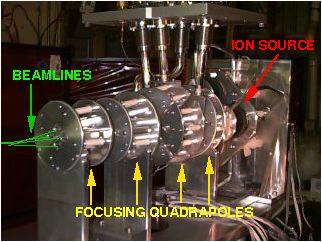Beam-Combining Experiment
Merging four or more separate beams into a smaller number of transport channels is an important economically motivated feature of a number of designs for induction-linac drivers. At lower ion energies, beam transport is most effectively performed in many small-aperture electrostatic focusing channels, due in part to lattice spacing and voltage-holding considerations. At a transition energy between 10 and 100 MeV, it becomes economically favorable to use a smaller number of larger-aperture magnetic focusing channels. The combining of the beams into a single channel will undoubtedly increase their emittance, and so the technical objective is to carry out this operation with acceptably low emittance growth and beam loss.
 The
combiner assembly was completed in the summer of 1996. The
figure shows the ion sources at the far right, followed by
the focusing quadrapoles.
The
combiner assembly was completed in the summer of 1996. The
figure shows the ion sources at the far right, followed by
the focusing quadrapoles.
This is, we believe, the first work of its kind. Previous experiments merged beams that had been created by passing a single beam through a mask containing several holes, and the merging was usually accomplished by simply transporting the beams on intersecting courses and relying on space-charge effects to make them coalesce. The new experiment will be the first in which active elements bend the beam trajectories, and the first to merge beams with a distribution function that is consistent with alternating-gradient transport. Since close packing of the beams minimizes emittance growth, the last element of the combiner uses many thin charged wires surrounding the beams, rather than a small number of large electrodes, to produce the combined quadrupole and dipole fields. Clearances between the beam edge and the field-producing wires is only a few millimeters, making alignment and field precision crucial design issues. Transverse phase space changes due to transport through the combiner and to beam merging will be measured in MBE-4 transport channels.
FourCs+ beams, each at 3-5 mA and 200 keV, will
be combined. The combiner, which doubles as a matching
system, consists of four focusing channels, each with four
quadrupoles plus the combined-function element mentioned
above. Steering is provided by articulation of the sources
and the second quadrupoles.
As a precursor to the combiner experiment, the dynamic aperture of the MBE-4 transport lattice was recently measured. An attempt to transport ~23 mA of Cs+ at 200 keV resulted in no more than 20 mA of current being measured at the end of the channel. Earlier, three-dimensional simulations of this transport problem had indicated a significant decrease in transportable charge above 17 mA due to the increasing strength of anharmonic focusing fields with radius. From both the experimental and the theoretical results, we feel confident that beam combining experiments with 4-5 mA will benchmark the design codes and allow exploration of beam-combining strategies that minimize emittance growth.
For more information on this experiment contact Peter Seidl.
For comments or questions contact WMSharp@lbl.gov or DPGrote@lbl.gov. Work described here was supported by the Office of Fusion Energy at the US Department of Energy under contracts DE-AC03-76SF00098 and W-7405-ENG-48. This document was last revised November, 2001
